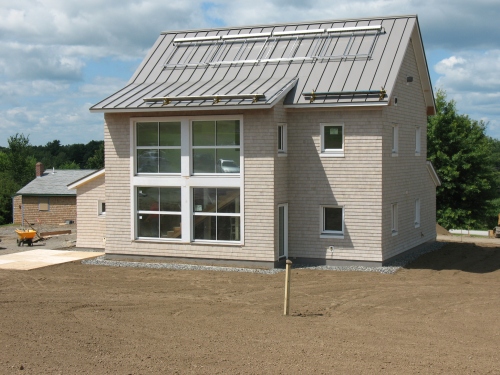In my last post I wrote about some of the characteristics necessary to achieve net gains in solar energy in cold climates. Since then I have corresponded with Alan Gibson, Principal, at GO Logic. He updated me on some of the final specs on the windows, which I’ll include here and correct in the previous post.
What is the contribution of passive solar to the success of TerraHaus? Using the specifications below, 70 degrees F as our temperature goal, and climate data from Bangor, Maine, the Passive House software model (PHPP) predicts that the south façade will contribute a net 7.8 million Btus annually to heating when all gains from sunlight and losses from conduction and radiation are included.
How Important is a 7.8 million Btu Capture?
It is this 7.8 million Btu net gain from solar energy captured through the windows that I want to put into perspective. How much energy is this, and how much of the heat load of TerraHaus does it cover?
First, this solar gain contributes one half of the energy needed to keep TerraHaus at 70 degrees F.
But what would this mean for those of us who burn oil or wood? A gallon of #2 fuel oil contains 138,500 Btus, but furnace inefficiency means that we probably capture only 115,000 Btus. Therefore, the 7.8 million Btu solar capture is the equivalent of about 68 gallons of fuel oil or about ½ cord of wood.
While this is ½ the space heating need for TerraHaus, it would not be as significant in most of our homes due to their higher heat requirement. Efficiency Maine reports that a typical weatherized home of 2000 SF in Maine will use 870 gallons of oil (about 6.5 cords of wood) to heat the home to 70 degrees for one heating season. (Many of us burn less, but our homes don’t average 70 degrees in the winter!) Compared to the heat load required for our homes, the amount of solar gain is not strikingly high.
Second, when thinking about windows note that most of the windows in our houses lose much more heat than they gain. For most houses, the function of windows is to provide daylighting and views to the outdoors rather than solar gain. These functions cost us in fuel use. Whether a building is passive solar or not, minimizing losses through high R-value, low infiltration, and minimal north-facing glazing is key regardless of any net gain. I’ll play with the PHPP model some more then publish some numbers on the insulation value of the TerraHaus windows over some standard options.
In Conclusion
TerraHaus’ remarkably low energy requirement is achieved through multiple factors, each contributing a modest energy savings. How do we achieve a 90% reduction in energy use as compared to typical code-compliant homes in our area? GO Logic’s Alan Gibson estimated the following from their GO Home Prototype in Belfast, Maine.
-
29% from improved insulation (R 50 walls, for example)
-
27% from improved air sealing
-
24% through carefully specified windows (reduced losses as compared to standard windows, standard glazing size and position, plus gains from solar)
-
10% from heat recovery ventilation
The Final Specifications (for my technical readers):
Large, South-facing Passive Solar Windows:
All Panes: U-value= 0.106, therefore, an R-value of 9.46
Tempered glass Panes (lower windows): SHGC = 0.5
Non-tempered glass (upper windows): SHGC = 0.61
All Frames: R = 5
R value of full window with all thermal bridging accounted for = 6.6
Other Windows:
R 11 glass and SHGC = 0.5
Doug Fox, Director, Center for Sustainability and Global Change, Unity College


Do the German windows use a gas ? My experience is that the gas charge is all but gone in ten years.